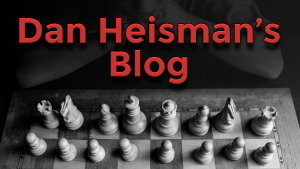Q&A with Coach Heisman Oct 25, 2013
"What do you tell someone who is losing too much?"
The main reason for losing too much is playing too many players who are much higher rated than you! So we have to ask, "Do you mean you are in a slump (If so, check out Breaking a Slump) and losing to players you don't normally lose to, or are you losing too much because your competition is expected to beat you?" 
In a similar manner, someone once told me "I stink at blitz - I lose all my games." I replied that was basically impossible if you were playing your peers. In the long run if you play people rated about the same as you in any aspect (say you are both terrible 600-rated blitz players) then you should win about half your games. If you lose all your games to a 600 player, then eventually you get rated about 200, and then you should win about half your games against your fellow 200's  .
.
We got into a little discussion of the misuse of "notate" instead of the regular verb "record". For more on that and how the words you use when you think may adversely affect your play, check out "What's in a Name?"
One of the big issues that surfaces periodically is the effect selected time controls have on one's improvement. Many online players think a 15-minute game is a slow game, but I am a pretty big believer that playing that type of time limit consistently can hinder (please don't interpret that as "reverse") your improvement. After all, 15*60 = 900 seconds and, at an average of 40 moves in a game, that's only 22.5 seconds per move. 22.5 seconds per move is hardly conducive to When you see a good move, don't play it, look for a better one, much less Is It Safe?, or practice in visualization. They don't give out OTB titles for games faster than 30 minutes, which is not a coincidence. More on that at Intermediate Time Controls Hinder Improvement.
"What do you think about Fred Reinfeld.com?" When I saw that question, my immediate thought was "I know Fred Reinfeld, but he died many years before the World Wide Web - what in the world is Fred Reinfeld.com?" Later it turned out that the questioner admitted he did not know where the ".com" came from, but meanwhile I decided to talk about Fred, one of the most famous US chess authors of all time, although maybe not the one whose books are the most admired.
Fred Reinfeld is best known for dominating the US bookstores' supply of chess books from the 1950's into the early 1970's. Many of these books represented various parts of a generic work The Complete Chess Player. But Reinfeld also authored some serious non-beginner books; for example, he collaborated with Reuben Fine to co-author Lasker's Best Games of Chess. Nonetheless, if you asked a non-serious US chess player in the 1960's if he had any chess books and he said "Yes", then, if you guessed it was written by Fred Reinfeld, you often got the response "How did you know?" 
In GM Denker's book The Bobby Fischer I Knew and other Stories, each chapter reminisces about one NY chess personality from the 1920's through 1950's. One thing I learned was that while Irving Chernev (the other most popular American chess author of my youth) was a weaker master, Reinfeld was a stronger one, just below the level of the New York's finest - which in those days was pretty coincidental with the US's finest. In honor of Reinfeld's affect on beginners, I have dubbed the 1-3-3-5-9 (P/N/B/R/Q) piece valuation "The Reinfeld values" because those are the values espoused in his books. For a much more advanced look on that subject, check out the award-winning article The Evaluation of Material Imbalances by GM Kaufman.
One viewer asked about a fortress. A fortress is a position where the player with less material can create a defensive setup and the player with superior force is unable to break through and win. There are many types of fortresses, but I showed a fairly well-known one:
...
...
...
...
...
...
...
...
...
...
...
...
...
...
...
...
...
In this position Black, when checked, can just move his king back and forth between g8 and h7 and otherwise shuffle his rook safely between f6 and h6. With the white king unable to approach, White cannot make progress and the rook and pawn allow black to draw against the queen. Interestingly, if we move the entire set up pieces one rank lower (so the black pawn is instead on g6, the rook on f5, black king on g7, etc) then somtimes White can win, but it's not so easy! In this specific case, the Shredder 6-piece tablebase (we only need 5, but it handles up to 6) tells me that the "down-one-rank" position would still be drawn.
"What's the difference between and 1800 player and a 2200 player?" Even speaking generically, this is a tough one to answer. You could say "On the average, 1800 players look 5 ply ahead and 2200 players 7" or "1800 players know about 300 nodes of opening book and 2200 players 2000+" or "1800 players occasionally play Hope Chess while masters rarely do." Any of these might be close to correct, but that's part of the point - there are many skills and knowledge involved in chess, so isolating one or two is not going to be very informative. Moreover, it is at best addressing an average and maybe not that many players gather around the norm of these measurements (i.e., there can be a large deviation of skill among 1800 players). For the traits and experiences of strong players I refer you to Traits of a Good Chess Player and Every Good Chess Player. Because thought process is a skill highly correlated with playing strength, a good source is my book The Improving Chess Thinker.
If you wish to review articles on previous shows, take the previous show review link.
The next show, Nov 8, will be on wife Shelly's birthday (so I have to finish on time!  ), and will be open to all.
), and will be open to all.



